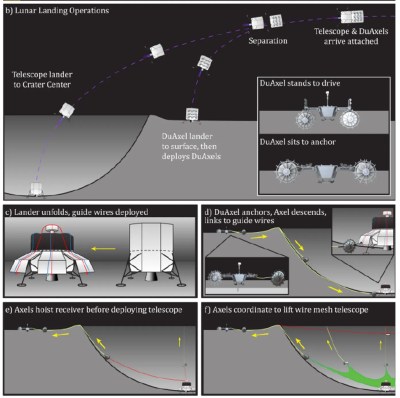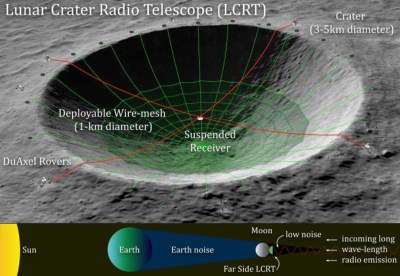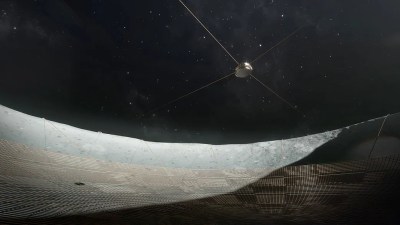When we first developed telescopes, we started using them on the ground. Humanity was yet to master powered flight, you see, to say nothing of going beyond into space. As technology developed, we realized that putting a telescope up on a satellite might be useful, since it would get rid of all that horrible distortion from that pesky old atmosphere. We also developed radio telescopes, when we realized there were electromagnetic signals beyond visible light that were of great interest to us.
Now, NASA’s dreaming even bigger. What if it could build a big radio telescope up on the Moon?
See You On The Dark Side Of The Moon

This concept has been on the cards for some time. NASA has created a plan for the Lunar Crater Radio Telescope, or LRCT. The idea is that NASA would select a large crater on the far side of the moon, roughly 3 km – 5 km in diameter. This natural structure would be used to create a gigantic radio telescope far bigger than could otherwise reasonably be built and deployed by a lunar craft.
The concept is naturally quite complicated, involving multiple robots working together to construct the giant structure. The concept involves effectively building a radio dish over 1 km wide. That’s far in excess of the largest radio telescopes on Earth, like the 500 m FAST in China, and the 305-m-wide destroyed husk that was Arecibo.
To achieve this, one plan would see a lander lofted into the center of the crater, while a secondary lander would land outside the crater, deploying multiple “DuAxle” rovers. The lander in the crater would deploy guide wires for a wire mesh to form the main structure of the dish. The special DuAxle rovers would anchor themselves around the perimeter of the crater, lowering one of their independent axles down towards the center of the crater on a tether. These independent axles would then help grab the guide wires tostretch the wire mesh over the crater. Meanwhile, other rovers would work together to hoist up a receiver to the focal point of the dish formed by the crater’s natural shape.

If it all sounds very complicated, that’s because it is. This method of deployment requires the cooperation of multiple rovers working in sync. Mistakes or mistimed maneuvers could tangle or destroy the mesh quite easily. There are also questions as to command and control. Getting signals to the far side of the Moon isn’t easy; NASA would either need to set up a radio relay or otherwise trust the rovers to do their job entirely autonomously.
The space agency has also explored other ideas for deploying the dish, too. One idea involves having a lander deploy the mesh by flinging it out as it descends into the crater. Alternatively, the lander could settle in the crater and then launch its wire mesh by firing it with projectiles, like some kind of lunar net gun. While these methods cut complexity somewhat, they pose greater challenge in actually anchoring the mesh onto the lunar surface.
However it’s deployed, positioning the telescope on the far side of the Moon is beneficial for doing serious science. The telescope would naturally be shielded from noisy emissions from Earth by the full mass of the Moon itself. Also, by virtue of its location, the telescope would be able to capture frequencies below 30 MHz. These frequencies are normally inaccessible with regards to radio astronomy on Earth, as signals in this spectrum from space tend to bounce off of the ionosphere.

NASA isn’t the only one thinking that the far side of the moon could be a good spot to gaze from. Along with international partners, China has developed its own project to observe the heavens from the far side of the moon, also aimed at investigating the radio spectrum. Much like NASA’s plan, the idea is to get out of the Earth’s ionosphere to listen to low-frequency waves, to help us learn more about the Dark Ages of the universe.
There are a great deal of questions that remain unanswered in radio astronomy, mostly thanks to the limitations of our humble Earth. Getting a radio telescope set up on the other side of the Moon, either in orbit or on the surface, could be a key way to unlock more secrets of the early universe. It will be no small task, but NASA has been pulling off increasingly complicated missions in each subsequent decade. A lunar radio telescope could just be the next amazing feat achieved with top-tier engineering and a fleet of helpful robots.

For now, work remains ongoing. NASA is yet to commit to a mission to deploy the LCRT. It’s still very much in the research phase, having received significant funding to further develop and explore the concept. There are also new challenges emerging as previously radio-quiet parts of the Moon are under threat. Ultimately, don’t expect to see a lunar telescope next year, but expect more movement on these concepts over the next decade.

















Giant grey ball in the sky with parabolic dish embedded into its surface. Rings a bell?
Look, up in the sky! It’a a bird! It’s a plane! *pause* That’s no moon.
Its a SPACE STATION!!!!!!!!!!!!! WOOOOOOOOO!!!!!!!!!!!!!!!!!!!!!!!
# of tons is the only thing that matters
too small a # and a lot of too fancy engineering?
way too risky
too big a #, possibly also with too fancy engineering?
way too expensive and risky
or an addmission that we got more important stuff to get done first!
So you’re saying the mass of the antenna launched to the moon needs to be “just right”?
The Goldilocks School of Aviation and Rocketry says we’ll be fine as long as we use mother bear’s rocket.
That’s a cool concept, I like it! Great way to use the dark side of the moon for science, watching for asteroids and seeing other planetary bodies.
s/dark/far/g — There is no “dark side” — only some permanently shielded craters near the lunar south pole.
Wouldn’t the dark side of the moon be the side not facing the sun?
Sure, but every new moon the side we see is technically the dark one.
But blocked from our radio noise (by the bulk of the moon) would make it ‘dark’ in a sense, and thus a good location for a radio telescope.
No inconvenient electrical storms, no animal defecating on equipment requiring regular cleaning, and no rain to rust the equipment.
The only concern would be the sun, when the dark side of the moon is facing it. It will need heat shield on top of the anchors and the receiver plus retractable shield on the bottom of the receiver because getting full blast of the sun would be like having a concert speaker at your ear. This assumes the dish will be near the moon’s equator. If the dish will be somewhere else, it may not need the retractable shield.
The aliens that live inside The Moon may not like having
[connection lost]
Wouldn’t you just move the receiver out from the focal point of the telescope? I assume they sometimes had to do that with Aricebo too.
There are so many engineering challenges to this that I don’t know where they’ll begin. With no atmosphere to block the sun or to retain warmth, the lunar surface temperature can vary from a daytime high of 250F (120C, 400K) to a chilly nighttime of -208F (-130C, 140K). Aluminum’s coefficient of expansion is roughly .000013 m/degree C. So an aluminum wire hung over a 5km crater experiencing a 250C temperature differential will shrink or expand by over 16 meters over every diurnal cycle. That increase in length would introduce hundreds of meters of sag. With the temperature never remaining steady, the sag would constantly be changing. It would likely need to be compensated for at a coarse amount by varying the length of the wire at the anchors, and by a fine amount on the antenna array itself. Not to mention the stresses all the equipment will constantly undergo due to the temperature differential.
The cables have to be capable of supporting the weight of the central antenna array, and I can’t even guess the diameter of the cable needed to withstand that much tension. (Hint: watch the Aricebo cable failure video.) That size of cable certainly couldn’t be manufactured on earth and shipped in a single spool, so they’ll need to spin the cables on site, like they do for giant suspension bridges. I also don’t know what kind of anchoring system they could build on the moon to withstand that kind of pull, but it will need to be tied to the bedrock of the lunar surface. What kind of shape will the bedrock be in next to a 5km crater? Probably pretty damaged, making for even more challenge. And it still requires some kind of machinery that dynamically compensates for the changes in sag.
I think this is the kind of idea that can be explained simply, but to put into practice? Wow.
The one thing going in favor of a mission like this? The engineers rising up to meet all these challenges. This would be the tallest feather in anyone’s cap, ever.
The “dark” in “dark side of the moon” means “unknown” rather than “unlit.”
No.
The “dark” in dark side of the moon means “hidden from view”.
As in, we cannot directly observe it from Earth.
It is actually closer in meaning to “unlit” than “unknown”, because being unlit prevents you from observing it.
Kind of ironic if we think of Arecibo.
For years, the US had no money left to invest in Arecibo’s maintenance, while simultaneously they seem to have loads of have money to build a gigantic twin brother on moon.
I seriously don’t understand this world anymore. 😢
I think we have to consider that Arecibo was the 3rd largest radio telescope on Earth. Perhaps the thinking is “why spend money to keep #3 alive when we could use it toward building the biggest ever, in a location that is much more RF quiet and much less susceptible to damage from man, weather, wildlife, and flora/fauna”.
But Arecibo could transmit, too.
The others are receivers, as far as I know. 🙁
You think a lunasynchronous radio telescope satellite on the back of the moon be a good start?
There is no dark side of the moon, really. As a matter of fact it’s all dark.
Jodie Foster should be there to turn it on.
If it’s free of earth’s RF noise then we’ll have to build a backside fiber network, laser (opticals want a site here also) because lunar satellites will have to be silent on or near the backside. No talkie in your moon suit, miner!
Been thinking for a long time that the far side would be a good place for optical as well. Always faces outwards. Self scanning to a degree. Yeah’ you have temperature and light extremes but you can do solar observations there too. Much lighter structures, once we get them there.
A wire mesh is being described for the reflector material. A pre-woven conductive Fabric might be a better material to the line the crater for use as the reflector. A material similar to Faraday or EMF fabric that can be bought today. Heres a guy building VHF antennas out of the stuff.
https://youtu.be/kARWE0N0EEc?si=QitW03YcyWxN2HHg
Similar material is used to build unfolding umbrella reflectors for spacecraft and terrestrial use today.
For consumer use, Its relatively low cost stuff to experiment with, at under $20 a sq yard.
Meh. Can we not. Hundreds of cultures on Earth have considered the Moon sacred for many thiusands of years.
It will be no less sacred with a telescope on it.
If you suspect your house is haunted, I can tell with 100% certainty if you, in fact, have a ghost.
You don”t. There is no such thing.
Moon is same. Various holy rocks/hills/mountains, no different.
There was a nutjob astrologer who spent her life trying to sue NASA.
Good luck.
If I was Elon, I’d draw a ‘girl part’ on the moon by dispersing ‘pixels’ of pigment with little exploding rockets.
To settle this nonsense, once and for all. (I stole this idea from RAH.)
Also: To f with the tribals. ‘Argh. God is on the moon and watches with her sacred winking eye. We better stop beating our women.’
Also also: Deny everything. Must have been the Ruskies.
If Larry Flint was alive, he could have afforded to do this. Just for the lulz.
We could setup a crowdfund…The question is: Who’s winking eye?
Worst case?
Amazon draws their dog erection logo on the moon.
Overdrawn (like a bad tat coverup) by another richer.
Not done until moon is painted superblack by puritans.
Then LED grid landed by Pornhub.
Then taken over by Anonymous and used to render image of moon.
Occasional Goatse.
It will be no less sacred with a telescope on it.
“[…]bounce off ̶̶o̶f̶ the ionosphere.”
FTFY
HTH
Etc.
=]